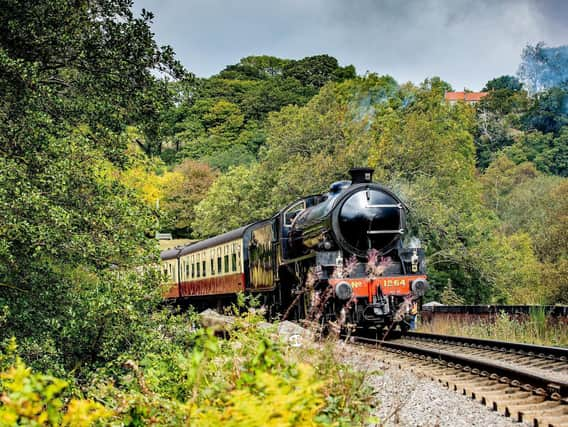What is the reason for our enduring fascination with steam trains?


That magic is one reason why 13 million visitors a year ride Britain’s preserved – or “heritage” – lines, generating half-a-billion pounds for the economy, and supporting thousands of jobs on this alternative rail network of 500 miles.
Affection for steam trains endures even though they left the national network more than half-a-century ago, and it is this peculiarly British love affair that Andrew Martin set out to explore in his new book, Steam Trains Today.
Advertisement
Hide AdAdvertisement
Hide Ad“It’s a uniquely British phenomenon,” said Andrew. “There’s nothing like it anywhere else in the world on the same scale. There are more than 100 of these preserved railways and their popularity is remarkable.”


He feels it is a weird phenomenon. “It says a lot of things about Britain that are the opposite of current mores. It’s about the past, it’s about a sense of community, it’s about love of the countryside and it’s about a love of engineering. All these things are retro, they’ve faded away, but they hang on in the preserved railways.”
Steam trains belong to the past, but it is their place in the present that the book focuses on. Andrew talked to those who run the railways, and those who ride them, finding a universal appeal to old and young alike.
“I don’t think I’ve ever seen anybody on a preserved railway look bored,” he said. “There is a magnetism to a locomotive, the scenery is beautiful and the carriages are so different. It can be like the Palace of Versailles in a Victorian carriage, compared to what you’ve got today.
Advertisement
Hide AdAdvertisement
Hide Ad“You only go at 25mph, but because of the motion, which is a bit rattly, it feels faster than that, so there’s a kind of physical excitement to it. The sound of a locomotive starting up can almost bring me to tears. It’s very moving. There’s a physicality about it, and that’s a very crucial thing.”
Nostalgia for a more elegant age of rail travel is also central to the appeal. Growing up in 1970s York as the son of a railwayman, Andrew, 58, could see the glory days fading. “I don’t remember steam, and I think that’s partly why I’m interested in it.
“The railway was being rationalised. My dad worked on British Rail and he was cost-cutting all the time, so there was this feeling of a system in retrenchment.
“When I discovered preserved railways, it was a chance to discover how railways were before I was born. It’s just a case of nostalgia, I suppose.
Advertisement
Hide AdAdvertisement
Hide Ad“Then I began to realise the extent of them. I found myself going onto the North York Moors Railway as a kind of default activity if I was bored. I’d drive up to Pickering and get on that train, especially if it was a quiet time.”
Yorkshire features prominently in his book. Besides the NYMR, it is home to another of the country’s best-loved lines, the Keighley and Worth Valley Railway, which gave Andrew his title when he saw a volunteer setting out a noticeboard with Steam Trains Today written on it at Haworth station.
Then there are the Wensleydale Railway, the Middleton Railway, in Leeds, one of the country’s oldest lines, and Embsay and Bolton Abbey Railway. All are affectionately evoked, as is a fragment of the old Derwent Valley Line in operation at the Yorkshire Farming Museum, near York.
Preserved lines are mostly survivors of the cuts to Britain’s rail network in the 1960s by Dr Richard Beeching, who axed thousands of miles to save money. Preservation societies – many made up of young people – sprang up to revive them.
Advertisement
Hide AdAdvertisement
Hide AdThe Keighley and Worth Valley Railway was one of the first, set up in 1962 to rescue the five-mile branch line originally built to serve the area’s dozen woollen mills. Its driving force was the late MP for Keighley, and later Bradford South, Bob Cryer.
Those pioneers are known as “Generation Steam”, and as they bow out after decades as the backbone of the 22,000-strong army of volunteers essential to running the railways, the lines face a challenge in recruiting younger people to replace them.
“It is an issue that Generation Steam is fading away. One guy who runs a railway said to me the trouble is, it’s a bit like the recruitment problems the Army has had – the work is very physical. People are not fit enough to do it, to be getting up at six in the morning and shovelling coal for eight hours, or climbing all over an engine to clean it. It’s hard work but that’s part of the appeal of being a volunteer and you’re very pleasantly tired out at the end of the day.
“We have a very high rate of volunteering in this country, and that culture is very important to the railways. You very rarely hear of a preserved railway closing down. None of them have done so as a result of Covid, so there’s a determination to keep them going.”
Advertisement
Hide AdAdvertisement
Hide AdCovid has been especially cruel to Generation Steam, as well as causing an exceptionally difficult year for the railways, which have been closed for most of it with no income from visitors.
Only now are they starting to run again, and publication of Steam Trains Today has been delayed for a year to coincide with reopening.
Britain’s turn away from coal is also a concern for the railways. “They are worried that they will not be able to access coal, but I believe it will be made available for historical or recreational purposes. I know at least one guy who’s trying to get a preserved railway going and he’s talking about running the engine on hydrogen. “It’ll have the steam and it’ll have the sound, and that’s the main thing.
“The railways are good for the environment, in a way. The example of the NYMR going to Whitby is one – it’s better to go on a steam train than it is to drive. The NYMR is doing what some of the other railways do, which is providing a useful public service. And they do a lot to preserve the countryside generally.”
Advertisement
Hide AdAdvertisement
Hide AdDespite the challenges, Andrew is optimistic about the future of heritage lines, not least because tourism authorities and councils prize the income and visitor numbers they generate. In the case of the NYMR, it carries 300,000 visitors a year to Whitby.
They are more and more professionally run, and local councils increasingly see the importance. You’ve got cases where the councils are keener on the railway than the railway itself and they’re saying, ‘Can’t you extend to here’, or ‘Can’t you keep running until November’.
“Some of the most successful lines might become more reliant on paid staff, and a lot of them – including the NYMR – have very strong initiatives to recruit young people. There is a very conscious effort to do that and I hope it works.”
Steam Trains Today is published by Profile Books at £16.99.
Writer inspired by our railways
Andrew Martin is the author of more than 20 books, both fiction and non-fiction, half of which have a railway theme, including Night Trains: The Rise and Fall of the Sleeper and Belles and Whistles: Five Journeys Through Time on Britain’s Trains.
Advertisement
Hide AdAdvertisement
Hide AdAfter growing up in York and university at Oxford, he qualified as a barrister but instead of practising law embarked on a writing career.
He is the author of the critically-acclaimed series of historical crime thrillers whose hero is railway policeman Jim Stringer.
Most of the books are set in Yorkshire, including the 10th, Powder Smoke, which was published in January.
His website can be found at jimstringernovels.com